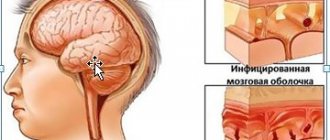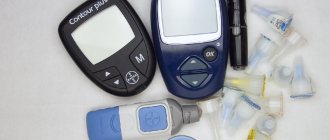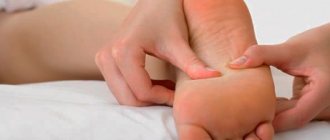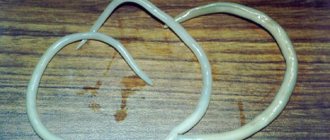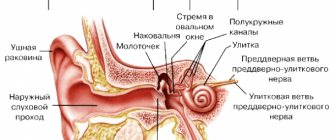What is diabetes mellitus? Reasons for the development of the disease. What causes blood sugar to rise
Diabetes is a chronic endocrine disease. There are 2 types of diabetes. Type 1 pathology is the result of damage to the pancreas, accompanied by the death of cells that produce insulin. This causes hormone production to decrease. Without this substance, glucose cannot be absorbed. It is not possible to get rid of diabetes forever.
Most often, the cause of the development of this form of the disease lies in a genetic failure. In this case, the pathology begins to manifest itself already in the first year of the child’s life, because the few functional cells present in the pancreas are unable to compensate for insulin deficiency.
diabetes mellitus is a chronic endocrine disease
In addition, type 1 diabetes can develop in people under 30 years of age. The cause of the problem lies in an autoimmune pathology, as a result of which the human immune system attacks the pancreatic cells that produce insulin. Factors that can trigger an autoimmune reaction include:
- genetic pathologies;
- severe viral infections;
- taking certain medications;
- exposure to pesticides and other chemicals;
- gland injury;
- chronic pancreatic diseases, etc.
The answer to the question whether diabetes mellitus of this type can be cured is negative, because this pathology develops after damage to the pancreas by more than 80%. It is impossible to restore dead tissue, and the patient will require insulin replacement therapy for the rest of his life.
Type 2 diabetes is more common. This form of the disease is not related to the ability of the pancreas to produce hormones. The pathology is characterized by an increase in tissue resistance to insulin. This form of the disease develops when elevated levels of glucose are present in the blood for a long time. By increasing insulin production, the body is unable to get rid of sugar. At the same time, tissues become less sensitive to insulin.
Diabetes of this type often develops against the background of obesity caused by systematic overeating. Hypertrophied fat cells can block the absorption of insulin. More often, this form of pathology affects people over 40 years of age. Factors that increase the risk of developing type 2 diabetes include:
- frequent stress;
- chronic diseases;
- genetic pathologies;
- taking potent drugs, etc.
It is possible to cure type 2 diabetes. Effective methods have been developed to reduce blood sugar levels and stabilize insulin production. Without treatment, this form of diabetes can gradually develop into type 1 pathology, requiring the administration of insulin.
Signs and symptoms of diabetes. Normal fasting blood sugar
The level of glucose in the blood, taken before meals, depends on the age of the patient. In children, 3.33-5.55 mmol/l is considered normal. In adults under 60 years of age, the norm is 4.11-5.89 mmol/l. For people over 60 years of age, the norm is 4.56-6.28 mmol/l. The most characteristic symptom of diabetes is a persistent increase in blood glucose levels. However, already at the initial stage of the pathological process the following signs appear:
- thirst;
- frequent urination;
- increased fluid intake;
- dry mouth;
- headache;
- cold extremities;
- slow wound healing;
- skin itching;
- numbness of legs and arms;
- weight gain, etc.
The patient does not always develop all the above symptoms at once at an early stage of the pathological process, but as the disease progresses, the manifestations worsen.
Diagnostics
A preliminary diagnosis is made based on the collected medical history and the results of a blood glucose test. If the sugar level is 6.1 mmol/l, this may indicate the presence of this disease. To clarify the diagnosis, the following studies are performed:
- glucose tolerance test;
- ketone research;
- urine test for glucose.
Additionally, studies can be carried out to identify autoantibodies to insulin, as well as to determine hormonal levels and proinsulin. To clarify possible hereditary pathologies that could cause the development of the disease, HLA typing can be performed. Additional techniques make it possible to determine which methods of therapy will be effective in reducing sugar and what kind of help with diabetes the patient will need to prevent the development of complications.
Only a doctor can make a diagnosis and prescribe treatment after a medical examination
Among other things, when making a diagnosis, it is necessary to take into account age, body weight, the presence of diseases of the reproductive system, blood pressure and other parameters. This helps determine the best diabetes treatments to lower sugar and stabilize insulin levels.
Consequences
Without targeted therapy, diabetes can lead to a deterioration in the quality of life, decreased performance and a number of serious complications. The consequences of this pathological condition include: renal failure;
- diabetic retinopathy;
- cataract, glaucoma;
- neuropathy;
- stroke;
- heart attack;
- atherosclerosis;
- neuropathy;
- hemorrhages;
- swelling;
- trophic ulcers;
- cachexia.
The most dangerous complications include ketoacidosis, which without urgent medical attention can lead to cerebral edema and death. In addition, a sharp decrease in glucose is dangerous in this pathological condition. This can cause hypoglycemic coma.
Lifestyle correction and necessary medications
If a patient is diagnosed with diabetes, treatment should begin as quickly as possible. The earlier the disease is detected, the more favorable the prognosis will be for the patient. In the later stages of the disease, serious, irreversible complications can occur.
As already mentioned, this disease cannot be completely cured, but the patient’s condition can be maintained. To do this, he must eat right and take insulin regularly. In addition, you can resort to traditional medicine. Some herbs help normalize well-being.
You need to adjust your diet. Foods should supply complex carbohydrates to the body, while simple carbohydrates should be excluded from the diet.
In addition, the following dishes should not be present in a diabetic’s diet:
- sweets;
- salty, fatty, fried, peppered, seasoned foods;
- alcoholic drinks and sweet soda.
It is also necessary to track the calorie content of your meals. It is important that the diet is balanced. The diet should have the correct ratio of proteins, fats and carbohydrates.
An integral part of diabetes treatment is the administration of insulin. You can do the injections yourself. Before administering the substance, you need to measure your sugar level. Injections are given if it is elevated. This measure allows you to maintain the patient’s body in normal condition so that he can live a full life.
People suffering from insulin-dependent diabetes should stock up on medication for future use. It is better if the supply is designed for more than one month. The substance will not deteriorate if stored correctly. This is necessary even when the patient does not need daily injections. But, if you suddenly need insulin urgently, it will be at hand.
The substance should be stored in a dark place, at a temperature not exceeding 8°C. You can do this in the refrigerator, but not near the freezer. If the product is stored in a warm place, under the influence of the sun's rays, it will lose its properties. For this reason, it is important to comply with storage conditions so that the medicine retains its benefits until the expiration date.
The bottle used can be stored indoors for no more than 45 days, avoiding direct exposure to sunlight. If the product is used once, then the opened bottle can be stored in the refrigerator for 90 days. Freezing should not be allowed, because after the medicine is thawed, an incorrect dose may be administered, which will make the patient worse.
It is allowed to use traditional methods, but only when this issue has been agreed upon with the doctor.
how to determine diabetes at home
Fighting diabetes at home with traditional methods
Herbs for diabetes are an important addition to drug therapy. Many folk recipes for diabetics that lower blood sugar should be used only after consulting a doctor. Before using such products, it is imperative to properly perform a test to accurately determine glucose levels. To stabilize the condition of diabetes at home, it is permissible to use special therapeutic exercises and diet therapy.
You should monitor your sugar levels regularly to avoid negative consequences.
How to measure blood sugar correctly at home
Before the test, you should check that the meter is working properly. It is important that the date and time on the device are set correctly. In addition, you need to make sure that the coding on the strip matches the coding present on the device. If all parameters are set correctly, you can start the test.
First you need to rub your fingers to improve blood microcirculation. After this, you need to thoroughly wipe the skin with alcohol or another antiseptic. Then you need to make a puncture with a lancet, i.e. with a special disposable needle. The strip needs to be blotted in the blood that appears. There is no need to completely soak it in blood.
After this, the strip must be placed in the device and wait for the characteristic sound signal to appear. After about 5-8 seconds, the result will be displayed on the screen. It is especially important to carry out tests regularly if type 1 diabetes is being treated with folk remedies.
Therapeutic gymnastics at home
When you need to quickly reduce glucose, it is recommended to use special therapeutic exercises. It is safe to perform calf raises. It is enough to do this exercise 20 times. To perform the next exercise, you need to take a lying position, raising your legs up and resting them on the wall. You need to stay in this position for 5 minutes. Then you should slowly lower your legs down and stand up after a minute.
In addition, squats will be useful. You should perform no more than 10-15 squats in one approach. You need to practice walking at alternating fast and slow paces. To develop the knee joints, you need to bend and straighten your legs while sitting on a chair. It is enough to perform the exercise 10 times.
treatment with folk remedies can curb the rise in blood sugar in type 2 disease
Treatment with medicinal plants. Recipes
Treatment of type 2 diabetes with folk remedies for older people will help to gently lower sugar concentrations and activate metabolism. You can fight diabetes with recipes based on ingredients such as:
- linen;
- chicory;
- grape leaves;
- burdock root;
- St. John's wort;
- nettle;
- Golden mustache;
- Jerusalem artichoke;
- wild garlic;
- viburnum;
- sea buckthorn;
- rose hip;
- carnation;
- rhubarb;
- aloe;
- mint;
- chaga;
- echinacea;
- mulberry, etc.
Wormwood is often used to reduce sugar levels in type 2 diabetes. To obtain a healing infusion, fill a 250 ml glass jar with fresh herbs and then add olive oil. The tightly closed container is left for 10 days. The composition is consumed before meals 2 times a day, 1 tsp.
Cloves for diabetes are used to stabilize sugar levels. To obtain an infusion, you need to pour 10 dried flowers with 1 glass of boiling water. The composition is simmered in a water bath for 15 minutes. The composition is placed in the refrigerator for 20 days. The finished product should be diluted at the rate of 12 drops per 1⁄2 cup of water.
St. John's wort for diabetes is used to restore blood vessels. To make a healing product you need 3 tbsp. l. pour 1 cup of boiling water over the herbs. The composition is infused for 2 hours. Take 1/3 cup 3 times a day. You can use this product for no more than 45 days in a row.
To make another healing remedy, mint and St. John's wort, 1⁄2 tsp each, rose hips - 2 liters and plantain - 4 liters are placed in a container. The mixture is poured into 1 liter of boiling water. You need to infuse the product for 1 hour. Take it 3 times a day before meals, 120 ml.
Can be used for pathological conditions such as diabetes, lemon and egg. These simple foods are part of a nutritional shake. Fruit juice and raw egg are mixed and drunk before meals in the morning. You need to be treated with this remedy for no more than 10 days. Egg and lemon should not be used in the presence of inflammatory pathologies of the gastrointestinal tract.
People suffering from diabetes need to monitor their diet
Cinnamon
Alternative medicine suggests using cinnamon in the fight against diabetes. The spice contains active substances that help effectively treat this disease even at home. Using cinnamon, you can achieve the following:
- reduce cholesterol levels;
- prevent the occurrence of blood clots;
- improve the condition of blood vessels;
- reduce sensitivity to insulin;
- reduce blood sugar levels.
You can simply add cinnamon to cooked foods or take it with honey. To prepare this product you need the following:
- Pour a teaspoon of cinnamon into a glass of boiling water.
- Leave for half an hour.
- Add two teaspoons of honey to the cooled mixture.
- Keep the cinnamon and honey in a cold place for three hours.
Half of the resulting solution should be drunk in the morning on an empty stomach, the rest before bed. Another effective medicine is kefir with cinnamon. The drink is prepared and taken as follows:
- Dissolve cinnamon (half a teaspoon) in a glass of kefir.
- Let the product sit for 20 minutes.
- This portion must be drunk at one time.
- Kefir with cinnamon is drunk in the morning before breakfast and in the evening.
Aloe
Scientists have proven that aloe can quickly lower blood sugar, stimulate insulin production and heal diabetic wounds and swelling. For internal use you will need aloe juice. To get it, you need to do the following:
- Cut a few aloe leaves from a mature plant.
- Wash and cut into small pieces.
- Wrap the aloe in several layers of gauze and squeeze out the juice.
It is best to prepare a fresh portion of the product for each dose. In the morning on an empty stomach, drink two tablespoons of aloe juice, in the evening - one. Aloe is especially useful for women suffering from diabetes, as it has a positive effect on the skin.
For external use, you can use aloe juice. They soak gauze and make a compress, leaving the bandage on for several hours. You can also apply crushed aloe to the sore spot.
Patient reviews
Marina, 29 years old: “I suffer from diabetes. It's all due to genetic predisposition. Over the years it only got worse, so I consulted a doctor. In addition to medications, he suggested taking a decoction of golden mustache. I was treated with several drugs at the same time. This enhanced the effect. Managed to reduce sugar levels. So far the tests are satisfactory. I'm glad I used this decoction."
Igor, 41 years old: “Diabetes appeared with age. I never thought I would encounter this. The hospital recommended a garlic-based medicine. I used the product every day. I managed to recover in two months.”
Diana, 34 years old: “Improper nutrition has led to obesity and diabetes. I was very scared and rushed to the hospital, where they advised me to take a tincture of aspen bark. I am very grateful to this remedy, because I was cured within a month and a half.”
Lydia, 39 years old: “I was faced with diabetes. The hospital recommended rosehip medicine. I used it every day and thanks to this I was cured, which I am very happy about.”
Treatment of diabetes with vegetables
The most common vegetables help very well in treating this disease. Moreover, you must adhere to a certain regimen for taking vegetable medicines and recommendations, then a positive result will not be long in coming.
Pour a tablespoon of grated horseradish into a glass of sour milk and leave in the refrigerator for 8 hours. Drink a tablespoon half an hour before meals until the condition improves.
Bulb onions
Squeeze the juice from the onions, mix with medical alcohol in a ratio of 1: 1 (standard portion 0.5 l : 0.5 l), pour into a dark glass bottle. Take a tablespoon for 5 weeks. You can repeat the course after taking a twenty-day break.
Beans
In the evening, pour a few light beans with 100g of boiled water. In the morning, drain the water, eat beans an hour before breakfast, and drink water. Do this daily for 6 weeks.
Green beans
Place three tablespoons of chopped bean pods in a thermos, pour two cups of boiling water, and leave for at least 6 hours. Divide the resulting amount of infusion into three doses and drink during the day half an hour before meals. Prepare a fresh portion every day.
Garlic
Grind 3 - 4 cloves of garlic to the consistency of a homogeneous pulp, pour in 0.5 liters of hot boiled water. Leave for twenty minutes, then strain. Drink the infusion throughout the day, taking in small portions.


